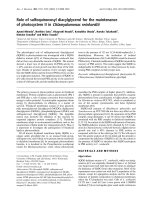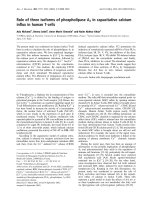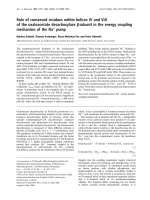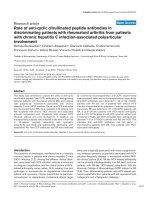Báo cáo y học: "Role of chlorhexidine gluconate in ventilator-associated pneumonia prevention strategies in ICU patients: where are we headed" pot
Bạn đang xem bản rút gọn của tài liệu. Xem và tải ngay bản đầy đủ của tài liệu tại đây (38.04 KB, 1 trang )
Available online />Page 1 of 1
(page number not for citation purposes)
We read with interest the recent study by Scannapieco and
colleagues [1], which concluded that twice-daily oral rinse
with 0.12% chlorhexidine failed to reduce the number of
potential respiratory pathogens in dental plaque, mortality, the
incidence of ventilator-associated pneumonia (VAP), the
length of intensive care unit (ICU) stay and the duration of
mechanical ventilation in trauma ICU patients.
Trauma ICU patients are similar to mixed ICU patients with
respect to risk factors for developing VAP, unlike patients
undergoing elective cardiac surgery. Use of 0.12% chlor-
hexidine decreases the incidence of VAP in patients under-
going elective cardiac surgery. In mixed ICU patients, chlor-
hexidine at concentrations less than 0.2% has consistently
been shown to have no benefit [2]. A randomized trial using
2% chlorhexidine has, however, demonstrated a reduction in
VAP rates in these patients [3]. A previous study showed that
12-hourly application of chlorhexidine has a sustained
preventive effect on biofilm formation [4]. The lack of benefit
from twice-daily oral cleansing with chlorhexidine in the
present study may be due to the lower concentration of
chlorhexidine.
The authors’ recommendation for investigation into mecha-
nical plaque removal with chlorhexidine would conceptually
have some added benefit. Mechanical plaque removal with
chlorhexidine, however, has not affected outcomes in ICU
patients in two studies [5,6].
We therefore suggest that further studies using oral chlor-
hexidine in ICU patients should be conducted using higher
concentrations (2%) to test the most appropriate frequency
of use, since oral cleansing is a nursing-driven intervention
and clinical trials with chlorhexidine are yet to demonstrate a
mortality benefit.
Competing interests
The authors declare that they have no competing interests.
References
1. Scannapieco FA, Yu J, Raghavendran K, Vacanti A, Owens SI,
Wood K, Mulotte JM: A randomized trial of chlorhexidine glu-
conate on oral bacterial pathogens in mechanically ventilated
patients. Crit Care 2009, 13:R117.
2. Panchabhai TS, Dangayach NS, Krishnan A, Kothari VM, Karnad
DR: Oropharyngeal cleansing with 0.2% chlorhexidine for pre-
vention of nosocomial pneumonia in critically ill patients: an
open label randomized trial with 0.01% potassium perman-
ganate as control. Chest 2009, 135:1150-1156.
3. Tantipong H, Morkchareonpong C, Jaiyindee S, Thamlikitkul V:
Randomized controlled trial and meta-analysis of oral decont-
amination with 2% chlorhexidine solution for the prevention
of ventilator-associated pneumonia. Infect Control Hosp Epi-
demiol 2008, 29:131-136.
4. Sekino S, Ramberg P, Uzel NG, Socranksky S, Lidhe J: The
effect of a chlorhexidine regimen on de novo plaque forma-
tion. J Clin Periodontol 2004, 31:609-614.
5. Pobo A, Lisboa T, Rodriguez A, Sloe R, Margret M, Trefler S,
Gomez F, Rello J: A randomized trial of dental brushing for
preventing ventilator associated pneumonia. Chest 2009, 136:
433-439.
6. Munro CL, Grap MJ, Jones DJ, McClish DK, Sessler CN:
Chlorhexidine, toothbrushing and preventing ventilator-asso-
ciated pneumonia in critically ill adults. Am J Crit Care 2009,
18:428-437.
Letter
Role of chlorhexidine gluconate in ventilator-associated
pneumonia prevention strategies in ICU patients: where are we
headed?
Tanmay S Panchabhai
1
and Neha S Dangayach
2
1
Department of Medicine, University of Louisville School of Medicine, ACB, 3rd Floor, 550 S. Jackson Street, Louisville, KY 40202, USA
2
Department of Neurology, Case Western Reserve University School of Medicine, 11100, Euclid Avenue, Cleveland, OH 44106, USA
Corresponding author: Tanmay S Panchabhai,
Published: 27 November 2009 Critical Care 2009, 13:427 (doi:10.1186/cc8165)
This article is online at />© 2009 BioMed Central Ltd
See related research by Scannapieco et al., />ICU = intensive care unit; VAP = ventilator-associated pneumonia.









